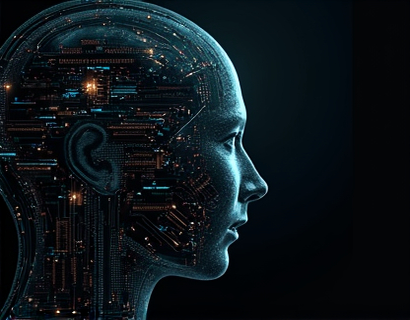Crypto and AI: Transforming Digital Interactions with Advanced Tech for Enhanced User Engagement
The intersection of cryptocurrency and artificial intelligence (AI) is revolutionizing the digital landscape, creating unprecedented opportunities for enhanced user engagement and connectivity. This article delves into the latest advancements in these technologies, exploring how their convergence is redefining the way we interact with digital platforms and services. For tech enthusiasts and professionals, understanding these developments is crucial, as they hold the key to unlocking new potentials in the tech sector.
The integration of AI into cryptocurrency systems has led to the creation of smarter, more efficient, and secure digital currencies. AI algorithms are now used to predict market trends, manage risk, and optimize trading strategies. These advancements not only enhance the performance of crypto assets but also improve the overall user experience. By leveraging machine learning, crypto platforms can offer personalized services, tailored to individual user preferences and behaviors, thereby increasing engagement and satisfaction.
One of the most significant impacts of AI in the crypto space is the development of decentralized finance (DeFi) applications. DeFi platforms utilize smart contracts and AI to provide financial services such as lending, borrowing, and trading without the need for intermediaries. This not only reduces costs but also increases accessibility, allowing users from around the world to participate in financial activities. AI-driven analytics further enhance these platforms by providing real-time insights and predictive models, helping users make informed decisions.
Beyond finance, AI is transforming various aspects of digital interactions. In the realm of blockchain technology, AI is used to enhance security and scalability. Machine learning algorithms can detect and prevent fraudulent activities by identifying patterns and anomalies in transaction data. This proactive approach to security ensures a more trustworthy environment for users, fostering greater adoption of blockchain-based solutions. Additionally, AI optimizes blockchain networks by managing resource allocation and improving transaction processing speeds, which is crucial for maintaining user satisfaction in high-demand applications.
The synergy between AI and crypto extends to the development of virtual assistants and chatbots. These AI-powered tools are integrated into crypto platforms to provide 24/7 customer support, answer queries, and guide users through complex processes. Natural language processing (NLP) enables these assistants to understand and respond to user requests accurately, creating a seamless and intuitive user experience. This not only enhances user engagement but also reduces the workload on human support teams, allowing for more efficient operations.
Another area where AI and crypto are making waves is in the creation of digital identities. AI-driven identity verification systems use biometric data and behavioral patterns to ensure secure and private user authentication. This is particularly important in the crypto space, where security is paramount. By integrating AI with blockchain, users can have control over their digital identities, choosing who can access their information and under what conditions. This level of control empowers users and builds trust in digital interactions.
The combination of AI and crypto is also driving innovation in the Internet of Things (IoT) sector. Smart devices equipped with AI can interact with blockchain networks to perform tasks such as data verification and transaction execution. This integration leads to more autonomous and intelligent systems, where devices can operate with minimal human intervention. For instance, smart home devices can use AI to analyze usage patterns and optimize energy consumption, while simultaneously recording transactions on a blockchain to ensure transparency and security.
In the context of user engagement, AI and crypto are enabling new forms of gamification and incentive programs. Cryptocurrency tokens can be used as rewards for participating in various activities, such as completing tasks, referring friends, or contributing to the network. AI algorithms can personalize these incentives based on user behavior, making the experience more engaging and motivating. This approach not only increases user participation but also fosters a sense of community and shared purpose among users.
The impact of AI and crypto on digital marketing is also noteworthy. Brands are leveraging these technologies to create more targeted and effective marketing campaigns. AI-driven analytics provide deep insights into user preferences and behaviors, allowing marketers to tailor their messages and offers accordingly. Cryptocurrency can be used as a medium for transactions, offering brands a new way to reward loyal customers and engage with their audience. This dual approach enhances the overall marketing strategy, leading to higher conversion rates and customer satisfaction.
Furthermore, AI and crypto are transforming the way content is created and consumed. AI-generated content, powered by natural language generation (NLG), can produce high-quality articles, reports, and even code. This not only saves time but also ensures consistency and accuracy. In the crypto space, AI can analyze vast amounts of data to generate insights and predictions, which can be presented in an easily digestible format for users. This democratization of information empowers users to make better-informed decisions and stay ahead in the rapidly evolving tech landscape.
The educational aspect of AI and crypto cannot be overlooked. Online platforms are using AI to create personalized learning experiences for users interested in these technologies. Adaptive learning systems adjust the difficulty and content based on the user's progress, ensuring an optimal learning path. This personalized approach makes it easier for beginners to grasp complex concepts and for advanced users to stay updated with the latest developments. AI-powered tutorials and simulations further enhance the learning experience, making it more interactive and effective.
In the realm of cybersecurity, the combination of AI and crypto is leading to more robust and resilient systems. AI algorithms can detect and respond to cyber threats in real-time, using machine learning to adapt to new attack patterns. Cryptocurrency and blockchain technology provide a decentralized and transparent framework for secure data storage and transmission. Together, these technologies create a multi-layered security approach that is difficult for malicious actors to breach, thereby protecting user data and maintaining trust in digital interactions.
The future of AI and crypto is promising, with ongoing research and development pushing the boundaries of what is possible. Quantum computing, for instance, has the potential to revolutionize both fields by providing unprecedented computing power. AI algorithms running on quantum computers could solve complex problems in fractions of the time currently required, leading to breakthroughs in areas such as cryptography, optimization, and data analysis. This could result in even more secure and efficient crypto systems, further enhancing user engagement and trust.
As the tech industry continues to evolve, the integration of AI and crypto will play a pivotal role in shaping the digital future. For tech enthusiasts and professionals, staying informed about these advancements is essential. By understanding the synergies between these technologies, individuals can better position themselves to capitalize on emerging opportunities and contribute to the ongoing innovation in the tech sector.
In conclusion, the merging of cryptocurrency and artificial intelligence is transforming digital interactions, driving growth, and enhancing user engagement. From smarter financial systems to secure identity verification and intelligent IoT devices, the applications are vast and varied. As these technologies continue to mature, their impact will only grow, offering exciting possibilities for the future of digital experiences.










































